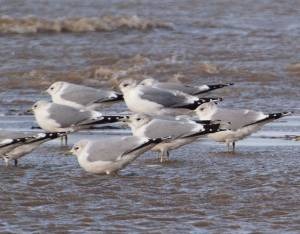Dr Phil Smith’s Wildlife Notes
February 2009
February is the month when the spring movement of birds, especially gulls and waders, back towards their northern breeding haunts, really begins in earnest. Large flocks of Common Gulls start to appear on the mossland fields and the shore. In modern times, these have increasingly been accompanied by a few Mediterranean Gulls and even the occasional American Ring-billed Gull. Last autumn’s storms blew lots of the latter across the Atlantic, exceptional numbers appearing in France and Spain. These will tend to fly north at this time of year, so they may turn up in Britain. Indeed, one was photographed at Seaforth Nature Reserve on 23rd.

The formerly rare Mediterranean Gull, with its ghostly white wings, jet-black head and large bright-red bill, is now a regular visitor to our shores and started breeding on the Ribble salt-marshes in 2001, five pairs nesting in 2003. I caught up with singles at Seaforth on 13th and 26th and at Birkdale on 10th but Derek Williams reported 5 – 6 birds with Black-headed Gulls on the mosses on 14th, while a colour-ringed adult was at Marshside. Finally, on the last day of the month, a search through about 6000 mixed gulls at Birkdale was rewarded with a smart pair of summer-plumaged Mediterranean Gulls. The impressive wader roost here included about 3000 Oystercatchers and 16,000 Knot; three Little Egrets were fishing in the pools on the Green Beach where I also found three Jack Snipe. The first Avocets were at Martin Mere by 23rd; two were seen flying north at Formby Point on 25th, six being at Marshside the following day.
Several bird-watchers have complained recently about people who allow or even encourage their dogs to chase roosting birds on the beaches. This has long been a problem locally but seems to be getting worse, partly because there are now more dogs around than I ever remember. Our shorebird flocks are internationally important and as they are about to fly thousands of miles back to the Arctic, these birds need to rest at high-water to conserve energy. Being constantly harassed by dogs means they use up precious fat reserves crucial to the success of their migrations.

Wintering birds are still much in evidence in February. The large flocks of Pink-footed Geese on the mosses during the first half of the month included several with plastic neck-bands, on which the three-letter combinations can be read with a telescope. One well-travelled individual, ringed in Iceland in July 2000, was seen in March 2001 in south-west Scotland and subsequently in Merseyside, Lancashire, Aberdeenshire and Norfolk. A graceful grey male Hen Harrier performed at Crossens Marsh on several occasions, being visible from the coast road with up to two Short-eared Owls. An excellent garden “tick” for me was a croaking Raven flying over my head on 21st.
The month ended with the first wild flowers of early spring. The tiny Common Whitlowgrass (Erophila verna) appeared in my garden, while Hairy Bitter-cress (Cardamine hirsuta) and Common Field Speedwell (Veronica persica) could be seen at Marshside.
